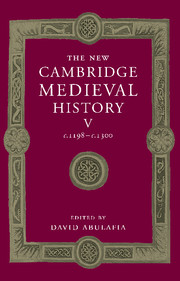Book contents
- Frontmatter
- Introduction
- Part I Common Themes
- 1 Social change in the thirteenth century
- 2 Commerce and communications
- 3 The vernacular
- 4 Art and architecture
- Part II The Church in the Thirteenth Century
- Part III The Western Kingdoms
- Part IV Italy
- Part V The Mediterranean Frontiers
- Part VI The Northern and Eastern Frontiers
- Appendix Genealogical tables
- Primary sources and secondary works arranged by chapter
- Index
- Plate section
- Map 1 Europe in the thirteenth century
- Map 3 France, c. 1260
- Map 5 Germany and the western empire
- Map 6 Genoa, Venice and the Mediterranean
- Map 8 The Latin empire of Constantinople and its neighbours
- Map 10 Aragon and Anjouin the Mediterranean">
- References
2 - Commerce and communications
from Part I - Common Themes
Published online by Cambridge University Press: 28 March 2008
- Frontmatter
- Introduction
- Part I Common Themes
- 1 Social change in the thirteenth century
- 2 Commerce and communications
- 3 The vernacular
- 4 Art and architecture
- Part II The Church in the Thirteenth Century
- Part III The Western Kingdoms
- Part IV Italy
- Part V The Mediterranean Frontiers
- Part VI The Northern and Eastern Frontiers
- Appendix Genealogical tables
- Primary sources and secondary works arranged by chapter
- Index
- Plate section
- Map 1 Europe in the thirteenth century
- Map 3 France, c. 1260
- Map 5 Germany and the western empire
- Map 6 Genoa, Venice and the Mediterranean
- Map 8 The Latin empire of Constantinople and its neighbours
- Map 10 Aragon and Anjouin the Mediterranean">
- References
Summary
WITH the undisputed revival of long-distance commerce in tenth- and eleventh-century western Europe, communications between north and south intensified. Historians such as Robert Lopez have categorised this era as the beginning of a commercial revolution. For two centuries Europe enjoyed undisputed prosperity even if the crises of the late Middle Ages can be found in embryo before the year 1300. Scholars have discerned the emergence of a new economy in this period, one grounded in the burgeoning cities and towns, sustained by artisan industrial production, and inextricably linked to inter national trade. The new commercial economy existed side by side with the traditional rural economy which would survive in many areas until the effects of the Industrial Revolution were generalised in the nineteenth century.
For most economic historians the thirteenth century represents the apogee of medieval economic expansion. The early fourteenth-century famines, with their culmination in the deadly famine of 1315–17, ushered in an era of late medieval crises. Prior to this period, there is general scholarly agreement that for about two hundred years, from the eleventh century well into the thir teenth, medieval Europe was in a phase of economic growth. By contrast, historians disagree about the nature of economic change thereafter in the fourteenth and early fifteenth centuries. The fruits of the commercial revolution were fully evident in the thirteenth century. As Gérard Sivéry has remarked, the new economy was, by the thirteenth century, characterised by cycles which are best detected in this pre-statistical era in the evolution of grain prices and in that of cloth exports. Significant inflation was evident in the thirteenth century.
Keywords
- Type
- Chapter
- Information
- The New Cambridge Medieval History , pp. 50 - 70Publisher: Cambridge University PressPrint publication year: 1999
References
- 8
- Cited by

